Dual Intel Xeon Gold 6230 Benchmarks
For this exercise, we are using our legacy Linux-Bench scripts which help us see cross-platform “least common denominator” results we have been using for years as well as several results from our updated Linux-Bench2 scripts. Starting with our 2nd Generation Intel Xeon Scalable benchmarks, we are adding a number of our workload testing features to the mix as the next evolution of our platform.
At this point, our benchmarking sessions take days to run and we are generating well over a thousand data points. We are also running workloads for software companies that want to see how their software works on the latest hardware. As a result, this is a small sample of the data we are collecting and can share publicly. Our position is always that we are happy to provide some free data but we also have services to let companies run their own workloads in our lab, such as with our DemoEval service. What we do provide is an extremely controlled environment where we know every step is exactly the same and each run is done in a real-world data center, not a test bench.
We are going to show off a few results, and highlight a number of interesting data points in this article.
Python Linux 4.4.2 Kernel Compile Benchmark
This is one of the most requested benchmarks for STH over the past few years. The task was simple, we have a standard configuration file, the Linux 4.4.2 kernel from kernel.org, and make the standard auto-generated configuration utilizing every thread in the system. We are expressing results in terms of compiles per hour to make the results easier to read:
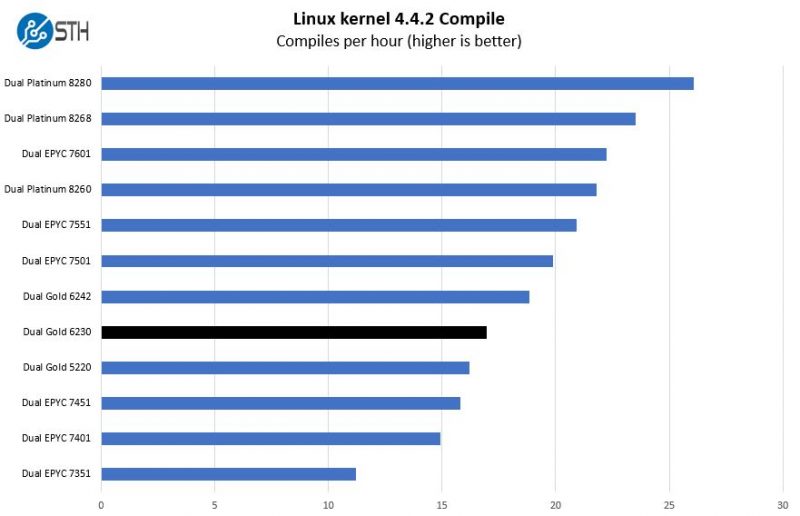
This chart highlights one of the more spectacular views. While the Intel Xeon Gold 6230 is far from the highest-end CPU. At the same time it is not that far from the 5x higher list price Intel Xeon Platinum 8280. The fact that not every workload is perfectly threaded and with its 3.9GHz boost clock and many cores, it is able to keep up to a large degree.
c-ray 1.1 Performance
We have been using c-ray for our performance testing for years now. It is a ray tracing benchmark that is extremely popular to show differences in processors under multi-threaded workloads. We are going to use our 8K results which work well at this end of the performance spectrum.
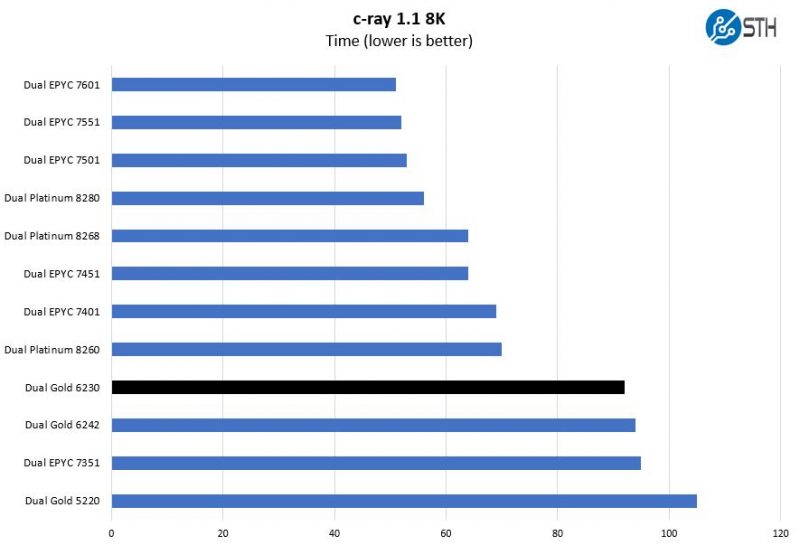
On the c-ray side, we can see that AMD performs very well. This is an architectural win for AMD’s 2017 “Naples” generation. We generally use c-ray for comparisons within generations and less generation-to-generation and vendor to vendor cases. Here, even the AMD EPYC 7401 24-core part ends up noticeably ahead.
7-zip Compression Performance
7-zip is a widely used compression/ decompression program that works cross-platform. We started using the program during our early days with Windows testing. It is now part of Linux-Bench.
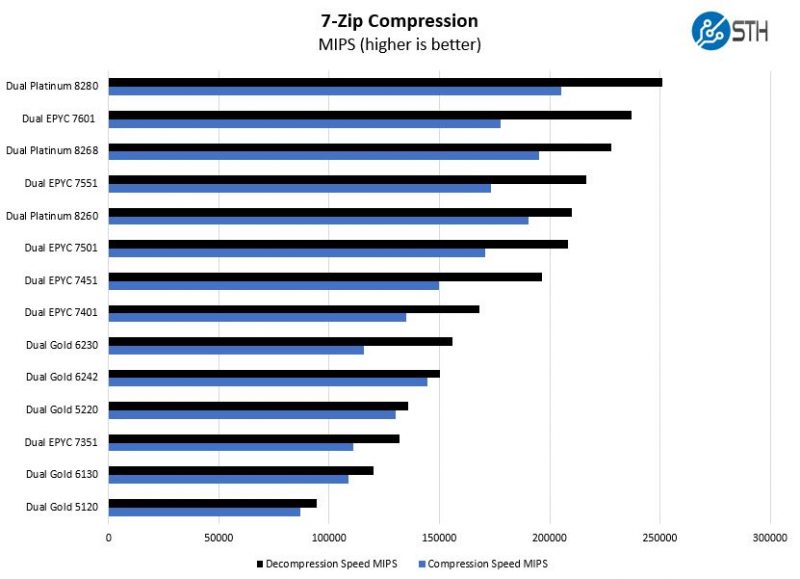
We had the Intel Xeon Gold 6130 numbers in this chart to show the performance delta. As you can see, the dual Intel Xeon Gold 6230 is a lot faster than the previous generation part.
NAMD Performance
NAMD is a molecular modeling benchmark developed by the Theoretical and Computational Biophysics Group in the Beckman Institute for Advanced Science and Technology at the University of Illinois at Urbana-Champaign. More information on the benchmark can be found here. With GROMACS we have been working hard to support Intel’s Skylake AVX-512 and AVX2 supporting AMD Zen architecture. Here are the comparison results for the legacy data set:
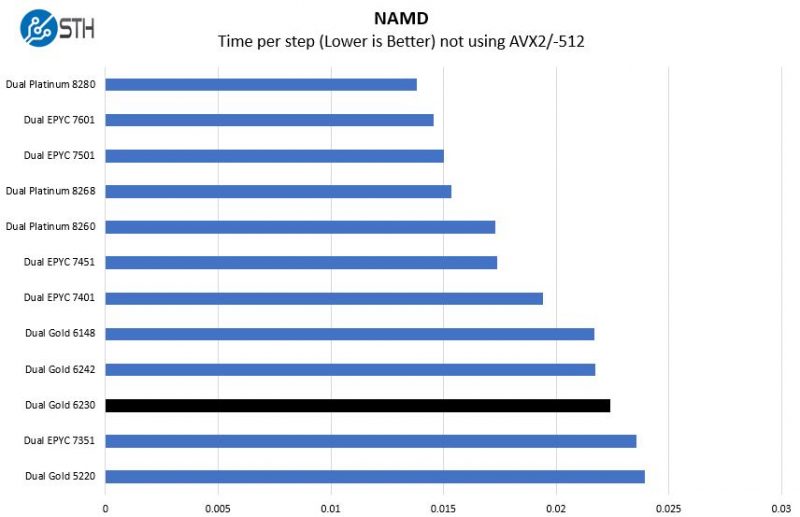
Interestingly here, the Intel Xeon Gold 6230 is running between the AMD EPYC 7351 (16-core) and AMD EPYC 7401 (20-core) parts in terms of performance. Also, with the core count boost, it is getting closer to the Intel Xeon Gold 6148 a popular HPC part.
Again, we are not running these in the highly optimized configurations that AMD and Intel were using around Computex 2019 which stirred up some controversy. See AMD EPYC Rome NAMD and the Intel Xeon Response at Computex 2019.
OpenSSL Performance
OpenSSL is widely used to secure communications between servers. This is an important protocol in many server stacks. We first look at our sign tests:
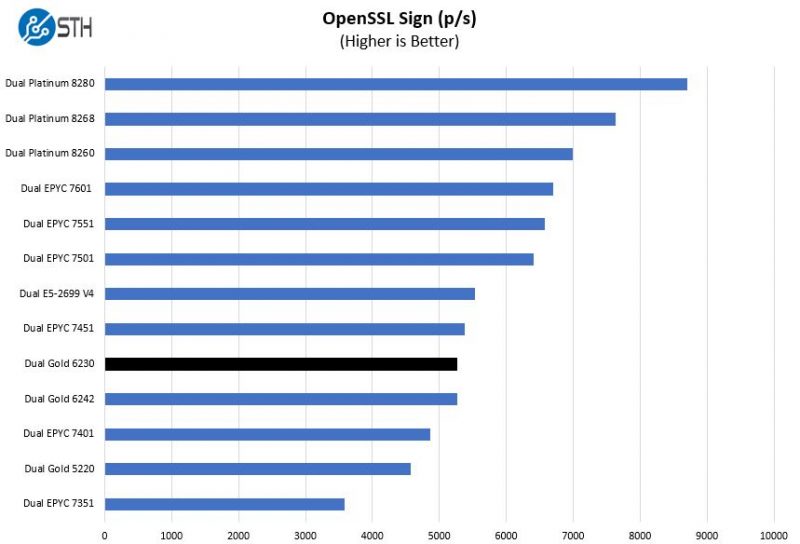
Here are the verify results:
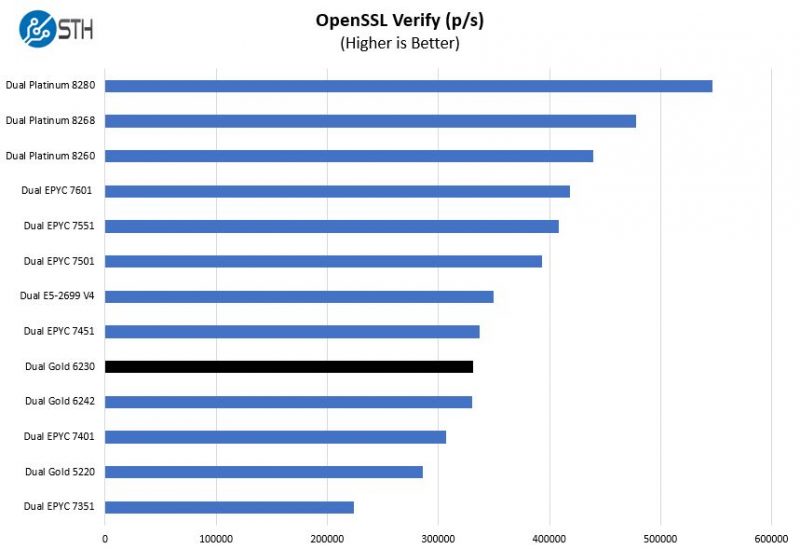
OpenSSL is a foundational technology in enterprise applications. As you may have noticed, the 16-core Intel Xeon Gold 6242 has been trading places with the Intel Xeon Gold 6230 on many tests. The Gold 6242 has a clock speed advantage while the Xeon Gold 6230 has a core count advantage.
UnixBench Dhrystone 2 and Whetstone Benchmarks
Some of the longest-running tests at STH are the venerable UnixBench 5.1.3 Dhrystone 2 and Whetstone results. They are certainly aging, however, we constantly get requests for them, and many angry notes when we leave them out. UnixBench is widely used so we are including it in this data set. Here are the Dhrystone 2 results:
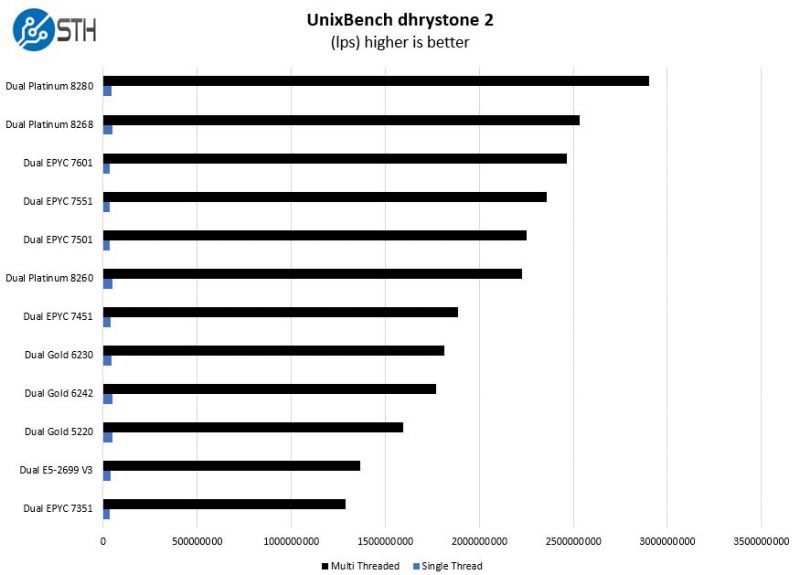
Here are the whetstone results:
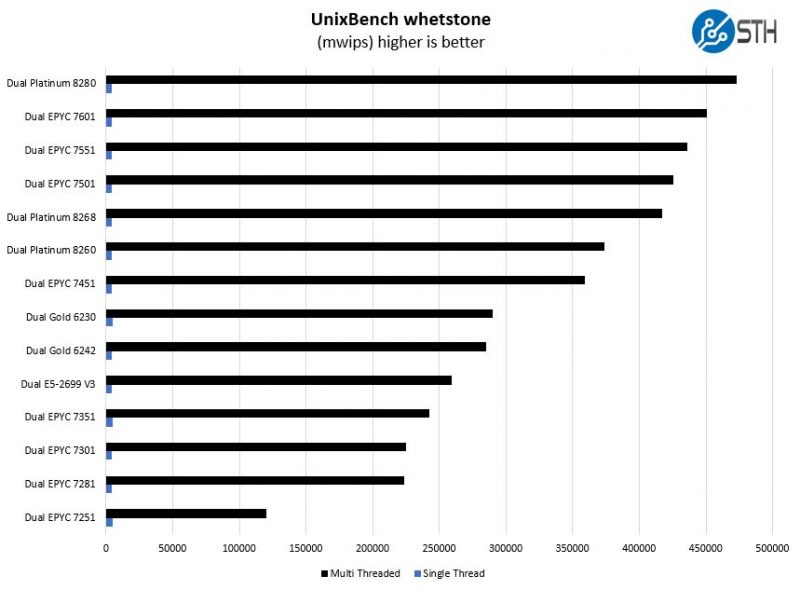
When we re-tested the Intel Xeon E5-2699 V3, the top chip (18-cores) of its era, the Intel Xeon Gold 6230 comes out well ahead. The new chip features more cores, higher turbo clocks, a 14% lower TDP, more memory channels, and is priced at less than half of the Q3 2014 part. If you are on a 3-5 year upgrade cycle, that shows just how much performance you can get with newer parts.
GROMACS STH Small AVX2/ AVX-512 Enabled
We have a small GROMACS molecule simulation we previewed in the first AMD EPYC 7601 Linux benchmarks piece. In Linux-Bench2 we are using a “small” test for single and dual-socket capable machines. Our GROMACS test will use the AVX-512 and AVX2 extensions if available.
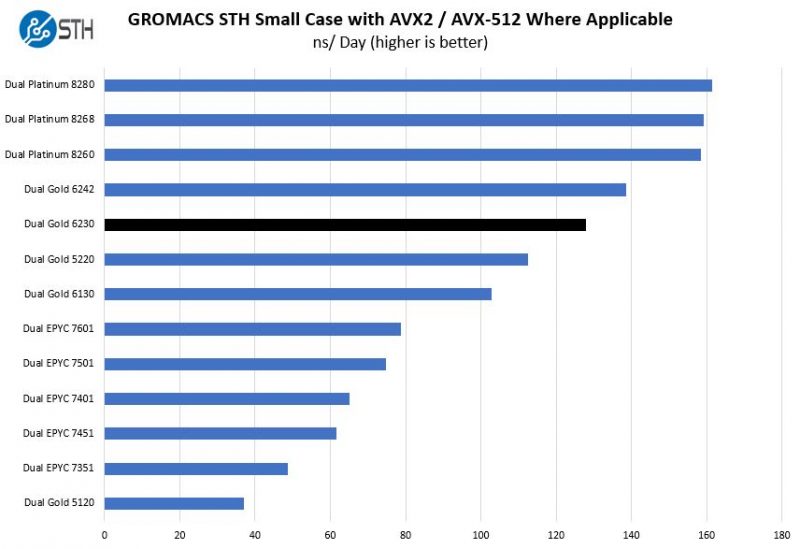
More software is being AVX-512 optimized. Here, one can see how big of a difference that makes with the Intel Xeon parts dominating the AMD EPYC 7001 series.
Chess Benchmarking
Chess is an interesting use case since it has almost unlimited complexity. Over the years, we have received a number of requests to bring back chess benchmarking. We have been profiling systems and are ready to start sharing results:
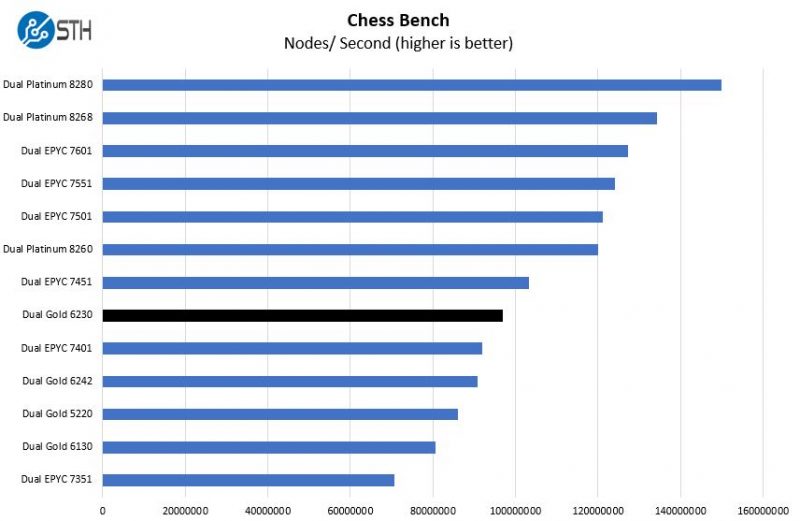
Even with modest 125W TDP, the Intel Xeon Gold 6230 performs well here. In this chart, that 25% or so performance increase to go to the dual Intel Xeon Platinum 8260 costs well over twice as much. The Intel Xeon Gold 6230 is still in the sweet spot of performance per dollar in the second generation Intel Xeon Scalable line.
STH STFB KVM Virtualization Testing
One of the other workloads we wanted to share is from one of our DemoEval customers. We have permission to publish the results, but the application itself being tested is closed source. This is a KVM virtualization-based workload where our client is testing how many VMs it can have online at a given time while completing work under the target SLA. Each VM is a self-contained worker.
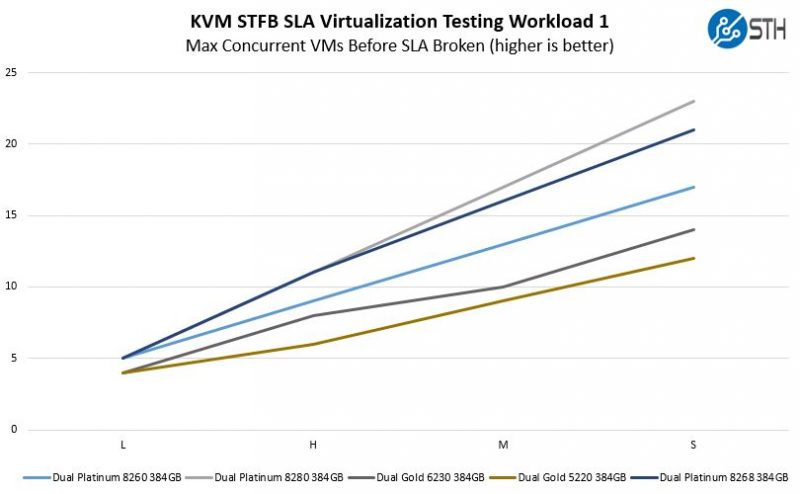
Overall, great segmented performance in the Intel Xeon Scalable line. There is a notable difference between what this chip can do compared to the lower-cost Intel Xeon Gold 5220 which is important for differentiation.
Next, we are going to discuss the solution’s market positioning and then give our final thoughts.




Can you make a short comparison of the 6230 against 6230N & 6248 ?
It’ll be interesting to see how performance scales up with the clock speed
and whether the increase of the performance justify the prices.
Hi Zibi, we are happy to. Do you have chips we can use?
We are a bit limited by the fact Intel has so many SKUs that we usually can only get 50-60% of the main SKU stack.
Hello Patrick
Unfortunately no.
I’m trying to get some 6230N as the demo inside 2U 4CPU system, but so far not much of the success.
They are really in the limited availability and not many vendors seems to have them, or plan to have them in the package I want.
BTW. Thank you for the great work!
Nice comparison!
6130/6230 are excellent cpu choice!
Would you be able to compare at least three generations of cpus? For instances 6230, 6130, and probably 2640 v4? This would help people looking for upgrade. Also, another idea would be to not remove cpus from your benchmarks and in a few years you’ll get a big enough history
Hi, in the first page it says “… we are then going to focus on power consumption then conclude with our final words on the processors.”, but I can’t find the part where you focus on power consumption. Is it the part on page 2 comparing TDPs? I’m curious about whether you measured the power consumption between the Intel generations and also how the AMD machines compare.